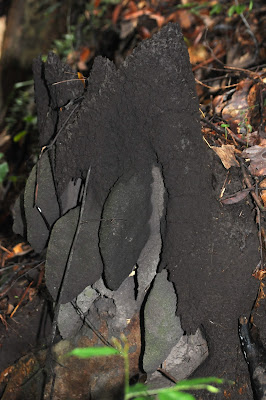On February 20, 2012, I joined my friend Hans Breuer (and some tourists he was guiding) for an excursion through the coastal forest behind the Permai Rainforest Resort.
..forcing many of the trees to straddle their roots over blocks of stone to reach the soil below.
This is a mixed lowland dipterocarp forest. The resort website lists thirty species of forest trees, including five dipterocarps. Many support woody vines snaking their way ion the canopy.
The stouter vines can seem like woody pythons encircling their hosts. There are real pythons here too; in October 2011 Hans found a five-metre-long Reticulated Python (Python reticulatus) here, relaxing in a forest stream. He has written a highly entertaining account of the event, with pictures (and expressions of frustrated jealousy from fellow snake enthusiasts).
These are the pitchers of, I believe, Nepenthes gracilis, a common lowland pitcher plant in Borneo. [NB: more likely to be Nepenthes mirabilis, also a common species - see Sean L's valuable comment below].
The forest floor seem particularly rich in fungi (at least, I assume that the peculiar whitish mass in this photo is a fungus - I can't imagine what else it could be).
I'm on firmer ground here - these are certainly bracket fungi (and remarkably colourful ones), though I can't be more specific than that. Bright orange bracket fungi are in fact quite common in Bornean forests.
Termite nests are a common sight in the forest.
Here is an extremely peculiar example. I would be most curious to know which termite made it, and what (if any) is the function of those udder-like hanging protuberances.
I would be equally curious to know what this photograph, taken of a forest pool, is showing. what are those spherical objects? As a naturalist, I'm ashamed to say that I haven't the faintest idea what I was looking at when I pressed the shutter.
I have had some help, here, though. The shiny object in the crevice of this tree trunk is a land snail.
Ok, it's a snail, but which one? My usual go-to expert on the subject, Gary Rosenberg, suggested I contact Menno Schilthuizen of Leiden University. Menno was kind enough to reply: "It's a bit hard to tell what species the photos represent (mostly because I am more familiar with the species from Sabah, and there is not that much overlap with the species from Sarawak), but it looks like Hemiplecta humphreysiana, or a form (?) of that species that is somewhat smaller and darker and is usually found at the coast. I can't tell the size from the images, but if it is this species, the shell should be about 30-40 mm across."
That's good enough for me. In addition to Borneo, the species is also found on the Malay Peninsula and in Sumatra.
That's good enough for me. In addition to Borneo, the species is also found on the Malay Peninsula and in Sumatra.
We saw, I am afraid, few birds. The Cream-vented Bulbul (Pycnonotus simplex) is one of a group of common, drab and frustratingly similar bulbuls on Borneo. This one has a white throat and vent. On Peninsular Malaysia it is considerate enough to have a distinctive white iris, but on Borneo its eyes are as red as those of its look-alikes.
Other than tourists, Silvered Langurs (Presbytis cristata) are the most common primates at the resort, and seeing those gentle leaf-eaters (the langurs, not the tourists) is always a pleasure.


















.JPG)
.JPG)
.JPG)
The langurs are adorable and its amazing to see how trees are able to surmount obstacles to reach a good patch of earth. Are the leaves in the pitcher plant image that of the pitcher? Coz it is petiolated and has a broad lamina, most likely to be mirabilis. N. gracilis have fully sessile and decurrent leaves. Primary hybrids with gracilis are gracilis-like in the sense that they have sessile leaves too.
ReplyDeleteThanks again for your help! I have made, and acknowledged, the correction.
ReplyDeleteNo worries. Sarawak has a lot of places where several Nepenthes species are living side by side, making identification difficult. They form swarm hybrids that are back-crosess or back and forward crosses with either parents. Another place is Genting Highlands, ramispina with sanguinea swarms are crazy and variable.
Delete